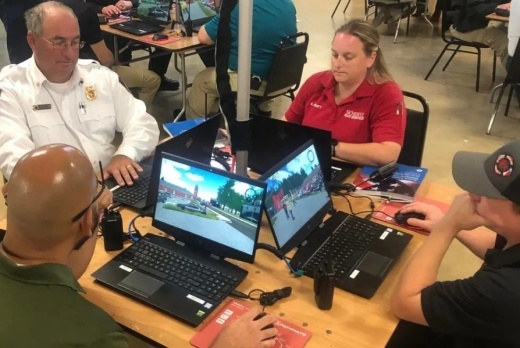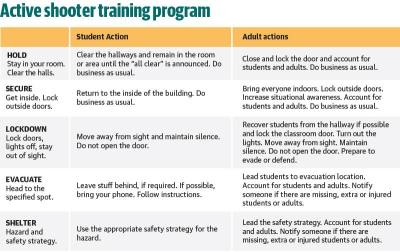Following the May 24 shooting at Robb Elementary School in Uvalde, legislators, families, communities and school districts have put school safety at the forefront of preparing for the 2022-23 school year.
State Rep. Elizabeth “Liz” Campos, District 119, which includes Schertz, Universal City and Live Oak, said she has had meetings regarding school safety, and constituents have called with concerns for children’s safety.
“We have been meeting with the superintendents of my district and the school [police departments],” Campos said. “I’ve met with some constituents that are very concerned about sending their children back to school, and of course on social media you hear all kinds of stories of parents that do not want to send their kids back.”
Ahead of the school year, officials with Judson ISD and Schertz-Cibolo-Universal City ISD presented safety measures and future plans to ensure student safety within their districts.
In addition to working with law enforcement, district officials are analyzing safety measures and considering new procedures and investments into campus security.
Campos said she would like to see teachers, schools and counselors get more involved in diagnosing issues with individual students.
“From what I have heard from constituents, they want safety; they want to make sure schools are safe,” Campos said. “We just need to make sure that monies are allocated and make sure that the mental health issue is addressed.”
Upcoming Judson ISD bond
To meet district safety needs and priorities, the JISD board of trustees on Aug. 18 called a Nov. 8 election, proposing a $345.2 million bond that—if approved by voters—will result in an estimated $0.01 per $100 valuation tax rate increase. District staff said nearly $218 million from the bond is earmarked for safety measures.
Trustee José Macias previously said the district should consider putting the bond on the November ballot, and he believes voters will be receptive to a bond that focuses on safety and security.
“The safety part of it I think is necessary, because as a district we do not have the resources to put forward what is necessary to upgrade every facility, and I think our community recognizes that,” Macias said.
The largest portion of the bond, Proposition A, is an estimated $146.7 million that would focus on safety improvements to campuses. Proposition B, estimated at $16.3 million, would include upgrades for the Wagner High School track and field as well as the tennis courts.
Proposition C is an estimated $55 million and would include upgrading existing camera systems, adding cameras to nonsecure areas, upgrading network security and upgrading access control for entrances.
Trustee Suzanne Kenoyer said it should go to voters as soon as it can.
“I don’t think we can wait,” Kenoyer said. “Should something happen at Judson ISD and we waited, I could never forgive myself. There are some things that are too important to wait on, and student and staff lives are one of those things.”
Increasing school officers
Alongside the bond discussion, the JISD board of trustees has shown interest in more immediate action that was to go into effect at the start of the school year.
On July 21, the board of trustees discussed the possibility of increasing the number of police officers within the district police department, which consists of 24 police officers and four vacancies as of July.
Communications Director Nicole Taguinod said each JISD police officer is School Based Law Enforcement Certified and has received active shooter training.
Taguinod said the JISD Police Department leads efforts to provide internal training that is aligned with the Texas School Safety Center, a university-level research center at Texas State University in San Marcos, and all administrative teams receive Civilian Response Active Shooter Events training.
Macias said he hoped the board of trustees would act to increase security before the beginning of the school year, which was Aug. 17.
“I’ll be very hard-pressed to not start this year, which is coming up very quickly, with some sort of statement and a deliberate action in doing something that is going to offer additional safety and comfort to our families and children,” Macias said prior to the start of the new school year.
Superintendent Jeanette Ball said the district has come up with different proposals that would help put additional security at campuses during the upcoming school year.
Schertz-Cibolo-Universal City ISD safety protocols
Both SCUCISD and JISD partner with the Southwest Texas Fusion Center, which is a collaborative effort of local, regional and national agencies with the goal of sharing information and resources to detect, prevent, investigate and respond to criminal and terrorist activity.
On May 17, the SCUCISD board of trustees held a presentation that explained how the district works with Schertz and Cibolo to provide resource officers and safety measures.
Ryan Clark, the district’s safe schools and truancy coordinator, said the main areas when considering safety include prevention and mitigation; preparedness; and response and recovery.
As of Aug. 1, SCUCISD had 11 resource officers. Four officers will rotate between the elementary and intermediate schools daily, according to a letter from the superintendent that was emailed to parents.
Clark said the district uses both digital and physical safeguards, including fences, barriers and software that can deter criminal activity.
For student training, there are six mandatory safety drills meant to teach students the safest actions they can take during a given emergency.
Of these drills, the fire drill occurs most frequently with one drill per month, and the lockdown drill occurs once per semester. A secure drill, an evacuation drill, a shelter-in-place for hazmat drill and a shelter for severe weather drill occur annually.
According to Director of Communications Deanna Jackson, SCUCISD officials are working on different options to ensure students have a safe school year.
"SCUCISD is dedicated to ensuring the safety of our students and educators across all of our campuses and facilities, and every option that makes our schools and facilities safer is being considered at this time,” Jackson said.
“As we evaluate these options over the remainder of the summer, SCUCISD will continue to consult with our partners in law enforcement and other safety officials to determine the most appropriate actions to take moving forward into next school year and beyond.”
Working with law enforcement
SCUCISD also partners with Schertz and Cibolo to provide safety for campuses around the district.
Cibolo Police Chief Bryan Hugghins and Fire Chief Mario Troncoso on June 30 explained to City Council how the city trains for school emergencies.
"We are working every single day, making sure that we are as prepared as we can be to address a situation, such as the one that happened in Uvalde,” Hugghins said.
Training in Cibolo includes “Stop The Bleed” training, active shooter management courses, advanced law enforcement rapid response training and more, Hugghins said.
Hugghins said Cibolo has also been involved with an integrated response group for Guadalupe County since 2018, which helps area law enforcement collaborate to best handle emergency responses.
“As you have seen in Uvalde, it wasn’t just [the] Uvalde [Police Department] or Uvalde ISD’s department that responded; law enforcement agencies from across the county came to assist,” Hugghins said. “That is what we expect. That is what we want to see, but we have to make sure we are able to work together, because communication is a huge stumbling block when something like that is going on.”
According to Director of Public Affairs Linda Klepper, Schertz police, fire and EMS departments conduct joint training on active shooter response scenarios that mirror the Rescue Task Force concept.
The RTF dictates that fire and EMS personnel will team up with police department personnel to enter a “warm zone” to provide immediate first aid to injured victims while police address the threat.
SCUCISD resource officers work directly with emergency response personnel from the district to develop site-specific plans and maps that assist during emergency responses at schools. Those are reviewed and updated annually to ensure new construction and policies are incorporated.
“The relationships that we have built and allowing law enforcement to come into our campuses and train, I think it has been really instrumental in the response that we have been getting,” Clark said.
Both Schertz and Cibolo also subscribe to the concept of an all-hazards response plan, and operations are structured under the National Incident Management System working under a unified command.
“The bottom line is, if you see something that is not kosher, please call us,” Hugghins said. “If we look at it and find out there was nothing to it, then no harm no foul. But, that one time it looks suspicious because it is suspicious, we would love to have that call first thing.”
Additional reporting by Tricia Schwennesen








